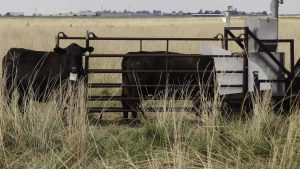
An initial 7,000 head of cattle were lost after the largest wildfire in Texas history, the Smokehouse Creek Fire, burned more than one million acres in late February. The total number of cattle lost, which excludes those euthanized due to injuries, is expected to be higher, according to the Texas Department of Agriculture.
The fire spanned an acreage equivalent to the size of Rhode Island in the panhandle, where over 85% of the state’s cattle population (beef and feed lot cattle and dairy cows) is located.
By Feb. 25, the Texas A&M Forest Service had responded to 56 wildfires burning more than 1.256 million acres.
In addition to losing cattle, farmers and ranchers lost farmland and grazing land, cotton crops, seven grain and seed dealers “were completely wiped out,” and thousands of miles of fence, structures that had been in families for generations, and roughly 120 miles of power lines were destroyed, CBS News reported.
Gov. Greg Abbott declared a state of emergency for 60 counties and House Speaker Dade Phelan launched an investigative committee on the wildfires. Hearings are already underway in Pampa, Texas, led by state Rep. Ken King, a Republican from the panhandle.
Texas’ top commodity is the beef cattle industry, accounting for $15.5 billion in market value in 2022, according to TDA data. Damage assessments from the wildfire are ongoing. Multiple resources are being made available to residents through state agencies and those who sustained losses are encouraged to report them to the state.
After the wildfires were contained, misery in the panhandle continued when dairy cows tested positive with the Highly Pathogenic Avian Influenza (HPAI), otherwise known as the bird flu. On March 24, HPAI was detected in dairy cows at one Texas farm and at two Kansas farms, the first in U.S. history.
Then the bird flu spread to other dairy farms.
On April 1, the U.S. Department of Agriculture confirmed five new H5N1 cases in dairy facilities. By April 2, the total increased to 11 in five states: seven dairy herds in Texas, two in Kansas, one in Michigan and one in New Mexico. A presumptive positive test result in Idaho is pending, the TDA said. The USDA’s National Veterinary Services Laboratories found that a Michigan dairy herd was infected after the facility received Texas cows, the CDC said.
Cattle suffering from HPAI exhibit flu-like symptoms, including fever and thick discolored milk, and produce significantly less milk. HPAI is believed to be introduced by wild birds and has not been detected in any beef cattle.
The bird flu poses no threat to the public, no dairy supply shortages are expected, and no contaminated milk has entered the market, the TDA says. The FDA and USDA also said there are no concerns about the safety of the commercial milk supply nationally because rigorous safety measures and pasteurization protocols are in place. Dairies are required to destroy or divert milk from infected cows.
Several state and federal investigations are ongoing. In Texas, the FDA, CDC, TDA, Texas Animal Health Commission, Texas A&M Veterinary Medical Diagnostic Laboratory, dairy veterinarians, and others, are continuing to evaluate symptoms among primarily older dairy cows, the TDA says.
On Monday, the bad news continued after the CDC reported that a Texas dairy worker who had direct contact with an infected dairy cow tested positive for HPAI after presenting with conjunctivitis. The employee was the second human case of the bird flu in the U.S. and the first to get it after being exposed to cattle in U.S. history, the CDC reports. The first human case of the bird flu was reported in Colorado in 2022.
No human has died from the bird flu in the U.S., the CDC says. It “has been monitoring for illness among people exposed to H5 virus-infected birds since outbreaks were first detected in U.S. wild birds and poultry in late 2021,” it says.
The bad news continued with the bird flu expanding to a poultry facility in the panhandle. On April 2, the TDA announced that Cal-Maine Foods, Inc., in Farwell, Texas, reported a positive bird flu test and temporarily shut down. It’s following USDA guidance for poultry infections, including depopulating 1.6 million laying hens and 337,000 pullets, or 3.6% of its flock, the TDA said.
Bird flu symptoms include mild respiratory signs, nasal discharge or sneezing, decreased feed consumption, ruffled feathers, and decreased egg production. Birds exhibiting symptoms are tested and cases are reported to state and federal agencies.
The Texas poultry and eggs and the dairy industries are the second and third top commodities in Texas, behind the beef cattle industry. They accounted for $5 billion and $3.5 billion, respectively, of market value in 2022, according to the TDA.
You can now read the most important #news on #eDairyNews #Whatsapp channels!!!
🇺🇸 eDairy News INGLÊS: https://whatsapp.com/channel/0029VaKsjzGDTkJyIN6hcP1K























